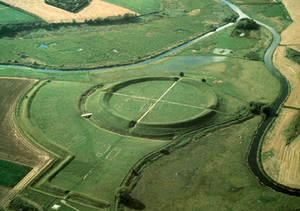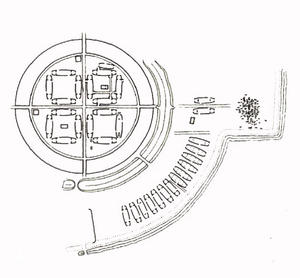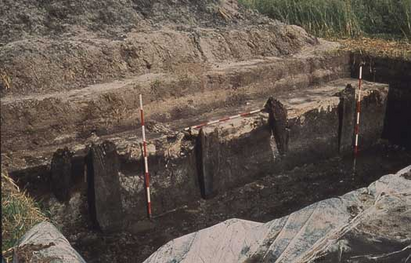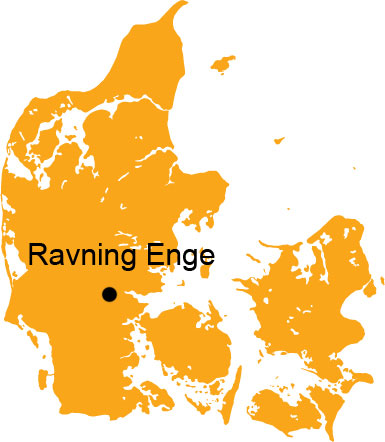Magnates' residences and royal seats
Magnates' residences from the Viking period have been found, which were very different to typical Viking farms. The residences were the homes of the most prominent people of the Viking Age. These individuals were either magnates, who were closely connected to the Crown, or else were actually kings themselves, at a local or regional level. The magnate’s homes were political, economic and religious centres. One such magnate’s residence was located at Lejre on Zealand.
The bridge over Ravning Enge
At the same time as the great ring fortresses were constructed, a number of bridges at challenging locations were also built. The most impressive of these is the bridge over Ravning Enge in the valley of the River Vejle, 10 km south of Jelling. The bridge was constructed between 979 and 980. It is 760 m long and 5 m wide and its carrying capacity is estimated to have been five tons. Around 1200 heavy oak posts and 600 cross braces were used to make the bridge. 350 hectares of oak woods were felled to produce the timber. The bridge exemplifies the engineering skills that the Vikings possessed. Those in charge of the bridge’s construction must have undertaken geotechnical investigations before the building work began, as the bridge is located in the only possible place in the area. It displays few signs of wear, which suggests that it was reserved for the exclusive use of the king and his men. After a short period of use, the new bridges were allowed to fall into disrepair as early as the year 1000, after which they were succeeded by fords.
Lejre – a royal seat
According to the Icelandic sagas and written sources from the medieval period, Lejre was supposed to have been the location where the first Danish royal family, the Scyldings, had their royal seat. However, these stories about the Scyldings should be regarded as fanciful myths and legends. Nevertheless, significant evidence now indicates that Lejre was in fact the headquarters of a royal family. Archaeological excavations have shown that Lejre has origins stretching back into the Iron Age, to the 6th century AD, and that it was already an important place at this time.
Furthermore, archaeologists have found a huge Viking settlement at Lejre, extending over an area of c. 125, 000 m2 and including a magnate’s residence. This consisted of a hall of royal dimensions - 48 m long and 11m wide. The hall is the largest known Viking building in Denmark. Official activities are likely to have taken place here.
A number of other buildings were also associated with the magnate’s residence – some up to 42 m long. The large houses are likely to have been for the magnate and his retinue, together with the guests who came to the visit him. These people may have been members of his family, his housecarls (soldiers) and magnates attending councils. The magnate’s residence and associated buildings were located on higher land, and were surrounded by a sturdy fence or palisade. Outside this area were workshops and another small settlement.
At the end of the 900s much evidence suggests that the royal power base on Zealand was supplanted by the Jelling dynasty led by Harald Bluetooth. Harald took over the magnate’s residence at Lejre, only later to move his headquarters on Zealand to Roskilde. Changing political and personal circumstances meant that another location was soon preferred.
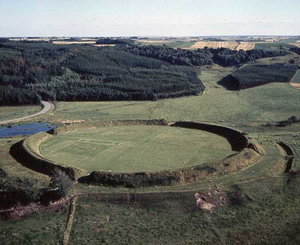
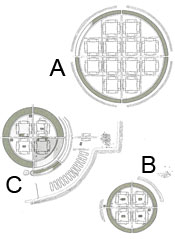
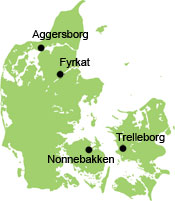
Royal construction
At the end of the Viking period, the large ring fortresses were built. There are four in Denmark: Trelleborg near Slagelse, Fyrkat close to Mariager Fjord, Aggersborg near Limfjord and Nonnebakken in Odense. All of the fortresses were erected in a short period around the year 980 and consist of a large circular earthwork surrounding settlements of varying sizes.
There is no indication that the fortresses were maintained, so they were apparently only used for a short period. Their homogenous construction and architecture indicate that they must have been built under central leadership.
In the year 980 Harald Bluetooth was king and there are several possible explanations for the construction of the fortresses. They may be seen in connection with the internal power struggles between Harald and Sweyn Forkbeard, as part of preparations against a military threat from the Holy Roman Empire or perhaps as a stage in military mobilization prior to a naval attack against England. Harald was responsible for various large-scale construction projects during his rule. These included the ring fortresses, great bridges and roads, as well as the enlargement of the defensive system known as the Danevirke.
Trelleborg
At Trelleborg there were 16 large houses within the inner rampart and 15 near the outer defence. The fortress was a military garrison, housing soldiers and their families. Weapons and tools were also kept at Trelleborg. In addition, ships were maintained near the fortress. Trelleborg’s burial place contained the remains of at least 157 men, women and children. These people may have been from the fortress, but could also have lived in a village located just 200 metres away. One grave provides evidence of conflict, as it contained the remains of 10 men between the ages of 17 and 35, who were buried at the same time. One of the men had suffered a brutal wound; his leg had been chopped off above the knee.
